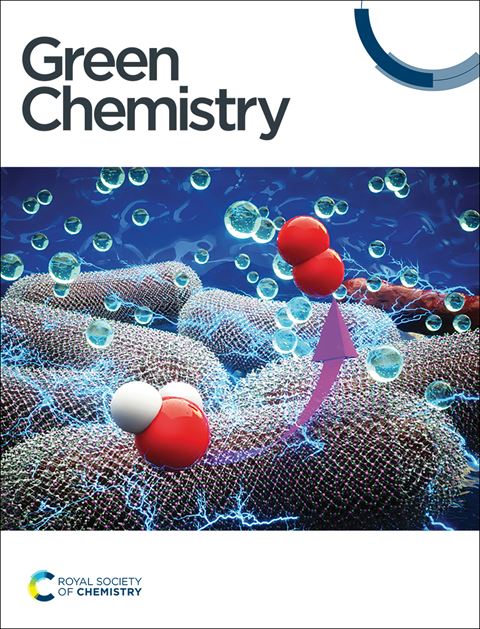PESf中空纤维内表面ZIF-8膜的绿色原位合成及其在氢分离中的应用
IF 9.3
1区 化学
Q1 CHEMISTRY, MULTIDISCIPLINARY
引用次数: 0
摘要
膜分离技术被广泛认为是一种可持续的选择,但实现膜本身的绿色制造仍然是一个重大挑战。为了确保可持续发展,按照“绿色膜材料和工艺的12项原则”制备膜是至关重要的。目前,大多数金属有机骨架膜的制备都需要在合成溶液中使用某些有毒的有机溶剂和适当的金属源。通过环保的绿色合成路线在聚合物中空纤维(HFs)上开发无缺陷的内支撑MOF膜是一项重要而具有挑战性的任务。本研究提出了在无有机溶剂条件下,在合成溶液中无外部金属源的情况下,在PESf(聚醚砜)-ZnO-HFs的内表面合成沸石型咪唑酸骨架-8 (ZIF-8)膜的直接连续流动生长方法。该方法通过2-甲基咪唑(Hmim)水溶液与嵌入在pesf - hf中的ZnO的直接配位,促进了原位形成良好互生的ZIF-8膜。ZnO颗粒不仅可以调节pesf - hf的孔隙率,还可以作为ZIF-8膜形成的金属源和成核位点。循环流动过程确保了HFs内Hmim水溶液的稳定和均匀供应,从而优化了HFs整个内表面ZIF-8晶体非均质成核速率和结晶条件的调节。所得的ZIF-8膜薄而连续,厚度约为800 nm。该膜具有优异的分子筛分性能,H2/CH4的理想选择性为23.1,H2/N2的理想选择性为13.6,H2透过率为3.56 × 10−8 mol m−2 s−1 Pa−1。此外,该ZIF-8膜具有优异的机械稳定性、热稳定性、长期稳定性和压力稳定性,以及出色的可重复性和可扩展性。在这项工作中开发的方法消除了对合成溶液中金属的需求,避免了溶液中ZIF-8晶体的形成,从而大大降低了与后续分离过程相关的环境风险和经济成本。这为在HFs内表面设计和合成MOF膜的简单、经济、可扩展和环保策略铺平了道路。本文章由计算机程序翻译,如有差异,请以英文原文为准。
Green in situ synthesis of ZIF-8 membranes on the inner-surface of PESf hollow fibers and application in hydrogen separation†
Membrane separation technology is widely recognized as a sustainable option, but achieving green manufacturing for the membranes themselves remains a significant challenge. To ensure sustainable development, it is crucial to prepare membranes in accordance with the “12 principles of green membrane materials and processes”. The preparation of most metal–organic framework (MOF) membranes currently requires the use of certain of toxic organic solvents and appropriate metal sources in the synthetic solution. Developing defect-free internally-supported MOF membranes on polymeric hollow fibers (HFs) via an environmentally friendly green synthetic route represents a significant yet challenging task. In this study, a straightforward continuous flow growth method under organic solvent-free conditions and without external metal sources in the synthetic solution to synthesize zeolitic imidazolate framework-8 (ZIF-8) membranes on the inner surface of PESf(polyethersulfone)-ZnO-HFs was proposed. This approach facilitates the in situ formation of well-intergrown ZIF-8 membranes through the direct coordination of an aqueous solution of 2-methylimidazole (Hmim) with ZnO embedded within PESf-HFs. ZnO particles not only regulate the porosity of PESf-HFs but also serve as both metal sources and nucleation sites for ZIF-8 membrane formation. The recirculating flow process ensures a steady and uniform supply of Hmim aqueous solutions within the HFs, thereby optimizing the regulation of the heterogeneous nucleation rate and crystallization conditions for ZIF-8 crystals across the entire inner surface of the HFs. The resulting ZIF-8 membranes were thin and continuous, with a thickness of approximately 800 nm. The membrane demonstrated outstanding molecular sieving performance, achieving ideal selectivities of 23.1 for H2/CH4 and 13.6 for H2/N2 mixtures at a H2 permeance of 3.56 × 10−8 mol m−2 s−1 Pa−1. Furthermore, this ZIF-8 membrane exhibited remarkable mechanical, thermal, long-term, and pressure stabilities, as well as excellent reproducibility and scalability. The method developed in this work eliminates the need for metals in the synthetic solution and avoids the formation of ZIF-8 crystals in solution, thereby substantially mitigating the environmental risks and economic costs associated with subsequent separation processes. This contribution paves the way for simple, cost-effective, scalable and environmentally friendly strategies for the design and synthesis of MOF membranes on the inner surface of HFs.
求助全文
通过发布文献求助,成功后即可免费获取论文全文。
去求助
来源期刊

Green Chemistry
化学-化学综合
CiteScore
16.10
自引率
7.10%
发文量
677
审稿时长
1.4 months
期刊介绍:
Green Chemistry is a journal that provides a unique forum for the publication of innovative research on the development of alternative green and sustainable technologies. The scope of Green Chemistry is based on the definition proposed by Anastas and Warner (Green Chemistry: Theory and Practice, P T Anastas and J C Warner, Oxford University Press, Oxford, 1998), which defines green chemistry as the utilisation of a set of principles that reduces or eliminates the use or generation of hazardous substances in the design, manufacture and application of chemical products. Green Chemistry aims to reduce the environmental impact of the chemical enterprise by developing a technology base that is inherently non-toxic to living things and the environment. The journal welcomes submissions on all aspects of research relating to this endeavor and publishes original and significant cutting-edge research that is likely to be of wide general appeal. For a work to be published, it must present a significant advance in green chemistry, including a comparison with existing methods and a demonstration of advantages over those methods.
 求助内容:
求助内容: 应助结果提醒方式:
应助结果提醒方式:


